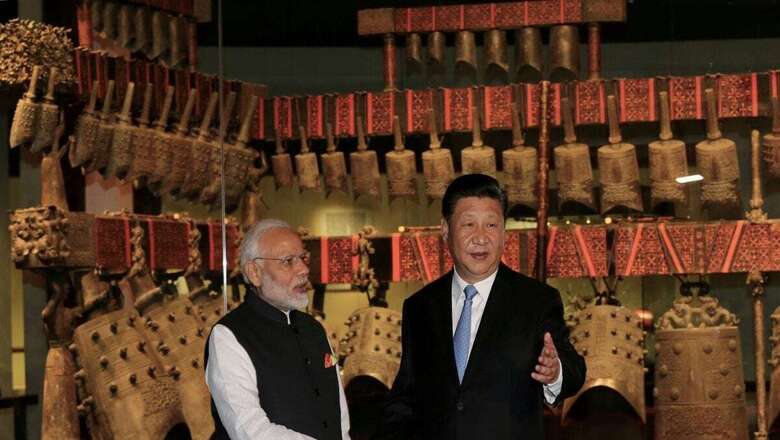
views
There are signs that India and China are making diplomatic headway in resolving the conflict along the Line of Actual Control (LAC). Efforts to that end have picked pace since July, when EAM S Jaishankar met his Chinese counterpart, Wang Yi, twice. Soon after, the Working Mechanism for Consultation & Coordination on India-China Border Affairs met twice, with their latest meeting in Beijing offering a glimmer of hope for Sino-India bilateral relations. Such a thaw will obviously need to be accompanied by disengagement between both sides from the two major flashpoints in Ladakh – the Depsang Plains and Demchok.
The statements put out by both China and India reflect the progress being made to resolve the border dispute and get bilateral ties back on track. After the working group meetings between India and China, the Chinese foreign ministry put out a statement saying both sides had “agreed to work together to turn over a new leaf in the border situation at an early date.” Meanwhile, India in its statement said that “the two sides had a frank, constructive and forward-looking exchange of views on the situation along the Line of Actual Control (LAC) to narrow down the differences and find early resolution of the outstanding issues.”
If disengagement is achieved soon, a one-on-one meeting between Prime Minister Modi and Chinese President Xi Jinping cannot be ruled out. In Russia, PM Modi reportedly accepted President Putin’s invite for the BRICS summit, which is scheduled for October. It is speculated that a meeting between PM Modi and Xi could take place on the sidelines of the BRICS summit. Such engagement between India and China’s top leadership will come as a major sign of tensions between both countries easing. It would also allow India more leverage to deal with the West, which under the leadership of a hawkish US, has been getting under New Delhi’s skin lately.
While China has been pushing India to allow bilateral relations to progress despite the border tensions, New Delhi has maintained that the two cannot be dehyphenated. That progress is being made to disengage in Ladakh also shows that India’s persistence and strong-headed approach is paying off.
In an interview with Newsweek during the heat of the Lok Sabha election campaign, Prime Minister Narendra Modi had made a very interesting pitch. He said, “Through positive and constructive bilateral engagement at diplomatic and military levels, the two countries will be able to restore and sustain peace and tranquillity at the borders.” He went on to add, “Stable and peaceful relations between India and China are important not just for our two countries but for the entire region and the world.”
The remark was welcomed by China, and it would not be an overstatement to argue that efforts to resolve the border dispute have picked pace after PM Modi’s pitch in April. Of late, Chinese state media has also adopted a more nuanced coverage of India, especially given the rise in tensions between Washington and New Delhi over a host of issues. China, for what it is worth, appears to be appreciative of India’s decision to balance ties between the West and the East, especially between Washington and Moscow. China has its own interests to worry about in the event India wholeheartedly joins the Western camp, and therefore, any signs of New Delhi being cautious are bound to be welcomed by Beijing.
Also, in July, India laid out its annual economic survey which hit the headlines for its perspective on China and how New Delhi should interact with it. The office of the Chief Economic Adviser offered two approaches that India can adopt: increasing imports from China or attracting more foreign direct investment (FDI) from the country. The Economic Survey also said, “To bolster Indian manufacturing and integrate into the global supply chain, India must connect with China’s supply chain.”
Simultaneously, there has been a noticeable movement in Chinese investment proposals in India. For instance, in March, a joint venture between MG Motor India and China’s JSW Group was finalised, with SAIC Motor divesting a 51 per cent stake. By May, the government began selectively approving Chinese investment proposals with Indian firms, and by July, plans were announced to form an inter-ministerial panel to expedite the approval process, requiring proposals to meet criteria such as excluding Chinese nationals from management and ensuring Indian firms hold majority stakes. Simultaneously, the government moved to fast-track visas for Chinese technicians. By late August, the panel had approved several Chinese investment proposals in the electronics sector.
Why India and China Need Not Escalate Further
It is a widely believed notion that neither India nor China can afford a war with each other at this juncture. For India, the focus over the next several years has to be on the economic front, while China itself combats the stress of a stagnating and indebted economy, apart from a demographic crisis that is only set to worsen. However, beyond war and conflict, there is another reason why India should do all in its power to restore normalcy in ties.
India’s supply chains are reliant on China, like most other countries in the world. Nearly two-thirds of Indian imports of electronic components, such as circuit boards and batteries are sourced from China. Similar is the case with solar batteries, used in the manufacture of solar panels. New Delhi also depends on China for many of its important pharmaceutical imports.
Unless India is able to set up alternative chains, any disturbance to these and the many other supply lines would have a cascading negative impact on the Indian economy. However, setting up alternate supply chains and decoupling from a manufacturing giant like China requires time and patience. So, it is in India’s best interest to settle the border dispute in the interim.
Also Read: Straight Talk | After Bangladesh, Civil War-Torn Myanmar on Edge, India Must Act with Strategic Prudence
What happens 20 years down the line can neither be predicted, nor controlled. All that we as a nation can do is prepare. A conflict with China may be inevitable, but it need not be imminent. Kicking the can down the road would be a prudent approach for now. India needs time not just to decouple its supply chains from China, but also to further modernise and strengthen its military so that it can fight on multiple fronts at once.
As India navigates its path towards becoming a global economic powerhouse, maintaining stable relations with China is crucial to avoid disruptive conflicts that could derail its progress. While tensions at the border persist, recent diplomatic engagements offer a glimmer of hope for resolution.
Views expressed in the above piece are personal and solely that of the author. They do not necessarily reflect News18’s views.

















Comments
0 comment